by Lisa Cooke | Mar 27, 2017 | 01 What's New, RootsMagic
Merging duplicate records in your family tree is important. Perhaps you have inherited a giant genealogy file (GEDCOM) from a relative. What now? Follow along in our series on Inherited Genealogy Files as we talk about how to merge the duplicates in your family tree.
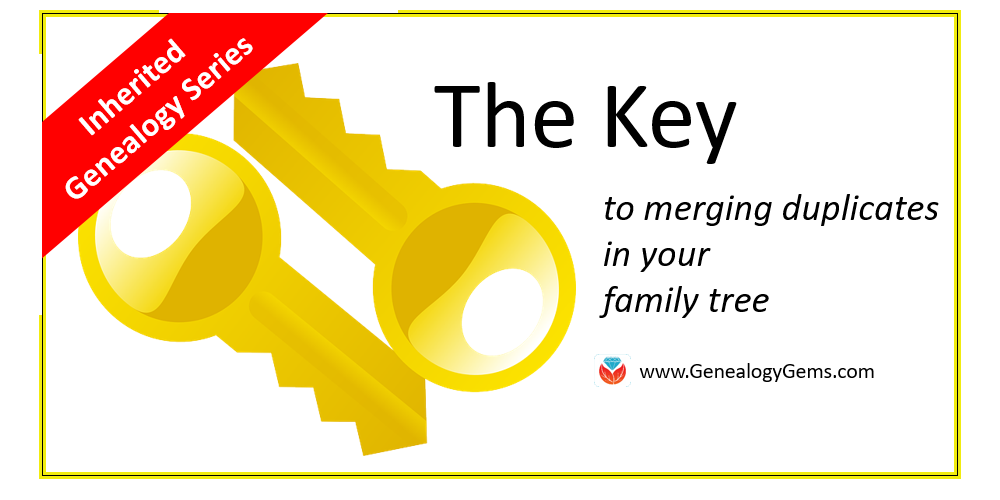
Have you cleaned up your family tree lately? Whether you have inherited a genealogy file from a relative or have been an avid researcher yourself, clean-up is necessary from time to time, especially as your database grows.
Merging Duplicates from an Inherited Genealogy File with RootsMagic
When you sit down to do your genealogy research, the last thing you want to worry about are duplicate names. Duplicates can be distracting and confusing.
You may have inherited a genealogy file or files in the form of GEDCOMs. (Read more on what and how to use a GEDCOM file here.) While inheriting this family history is great, it can also be a lot of work to clean-up, confirm the data, and add source citations where needed.
If you use RootsMagic or other similar software, it can be quick and easy to clean up duplicate names in your database. Start by running a duplicate search by clicking on Tools, selecting Merge, and then clicking Duplicate search merge.
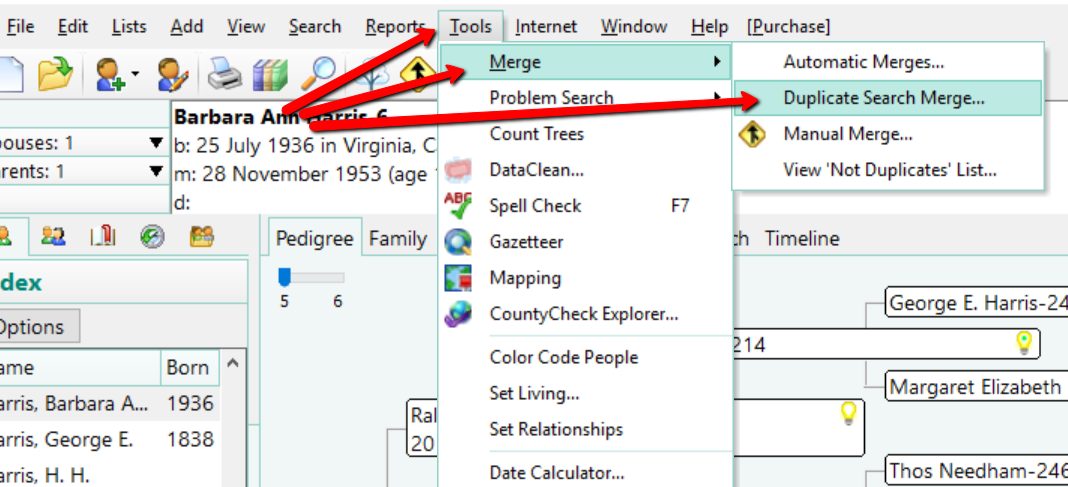
You can search for duplicates by surname or given name. You might consider running a duplicate search for sounds alike, as well. This is particularly important if you have merged two databases in which you and the other contributor may have used different surname spellings.
When you are ready, click Search for duplicates at the bottom of the box. The system will tell you how many duplicates it finds and allow you to compare them one-by-one.
If you find a duplicate, the primary person will be on the left and the matching record on the right. Whichever record/person is most correct, use the Swap button to move that record to the primary position on the left.
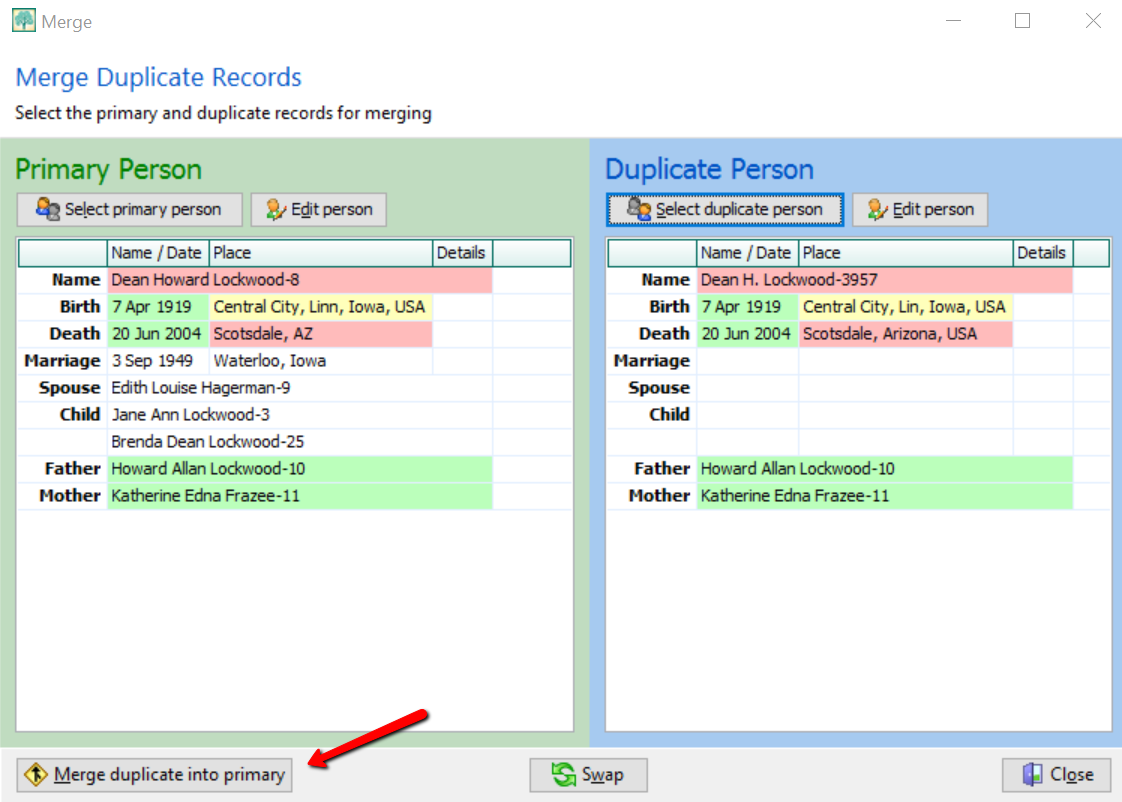
If you feel these are a match, click Merge duplicate into primary at the bottom left corner. You have now merged these two individuals. It should be noted that you do not actually lose any of the data of the duplicate person. If I find Dean Howard Lockwood in my index and double click on his name, a pop-up window appears and I see he now has two birth and death entries, however. To fix this, click on the duplicate fact to highlight it, then click Delete fact at the top.
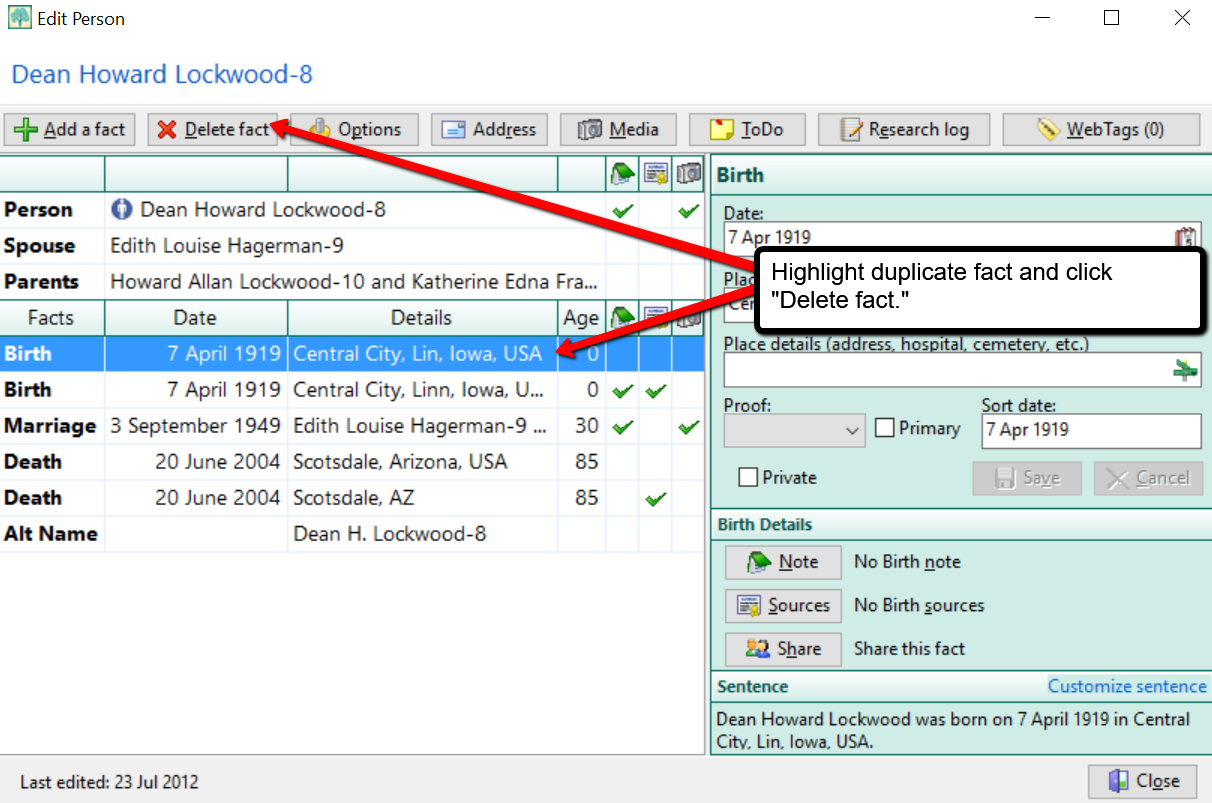
Cleaning Up Duplicate Places
You may not have considered cleaning up the duplicate places that exist in your file. For example, perhaps Great-aunt Susie liked to use the old format for place names. [i.e. , Ross County, Ohio] Notice the comma before the county name Ross. This was the way in which genealogists used to indicate Ross was the name of the county. Now, we use the more recent accepted format and change that to: Ross county, Ohio, United States. You can quickly merge these two places into one by clicking Lists at the top left, and choosing Place List.
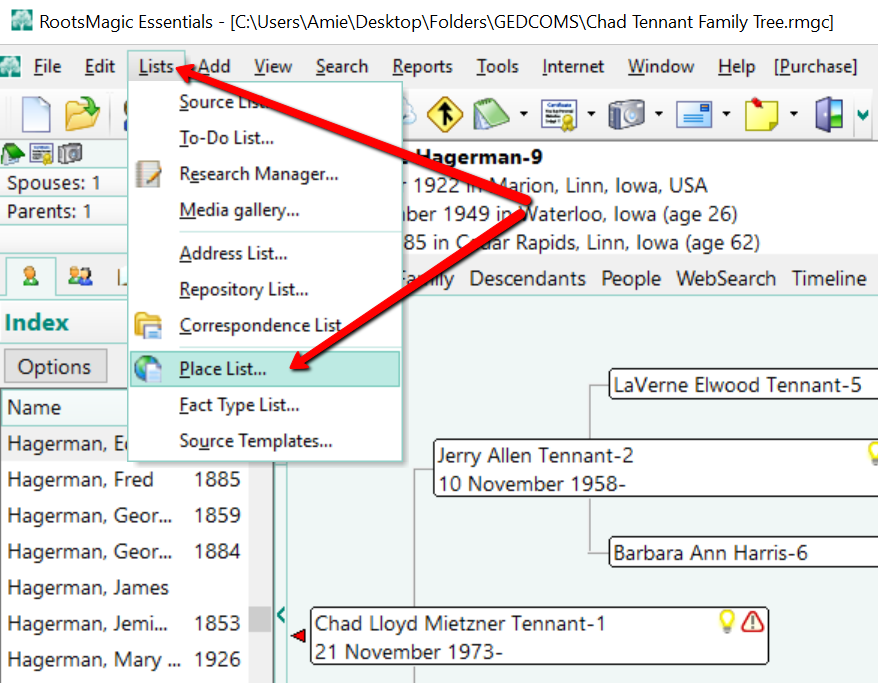
Now, choose the place you would like to fix and double click it. In the pop-up window that appears, simply type in the place name as you desire it to appear in your database.
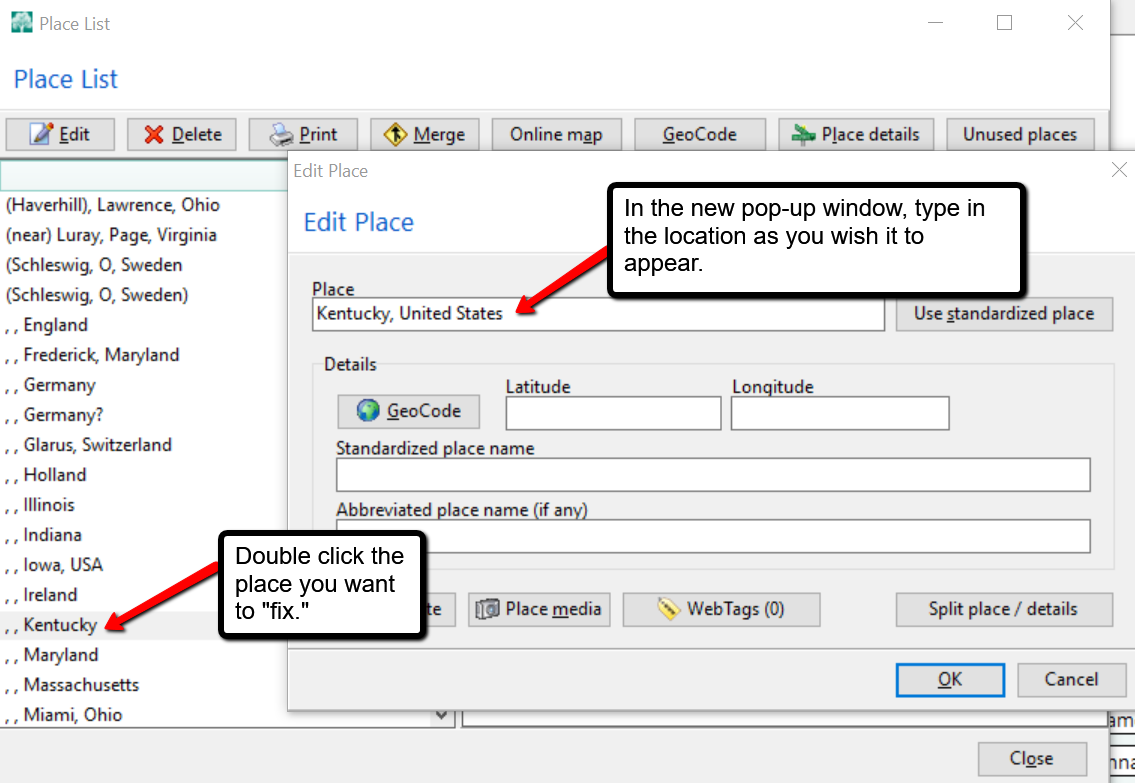
In the example above, we have changed , , Kentucky to Kentucky, United States and clicked OK. But wait, there’s one more step! You may notice your list now shows duplicates of Kentucky, United States or some variation. To fix that problem, click on the merge button at the top of the Place List pop-up window. A new window will pop-up and you can choose all the places you wish to merge together. Then, click Merge selected places.
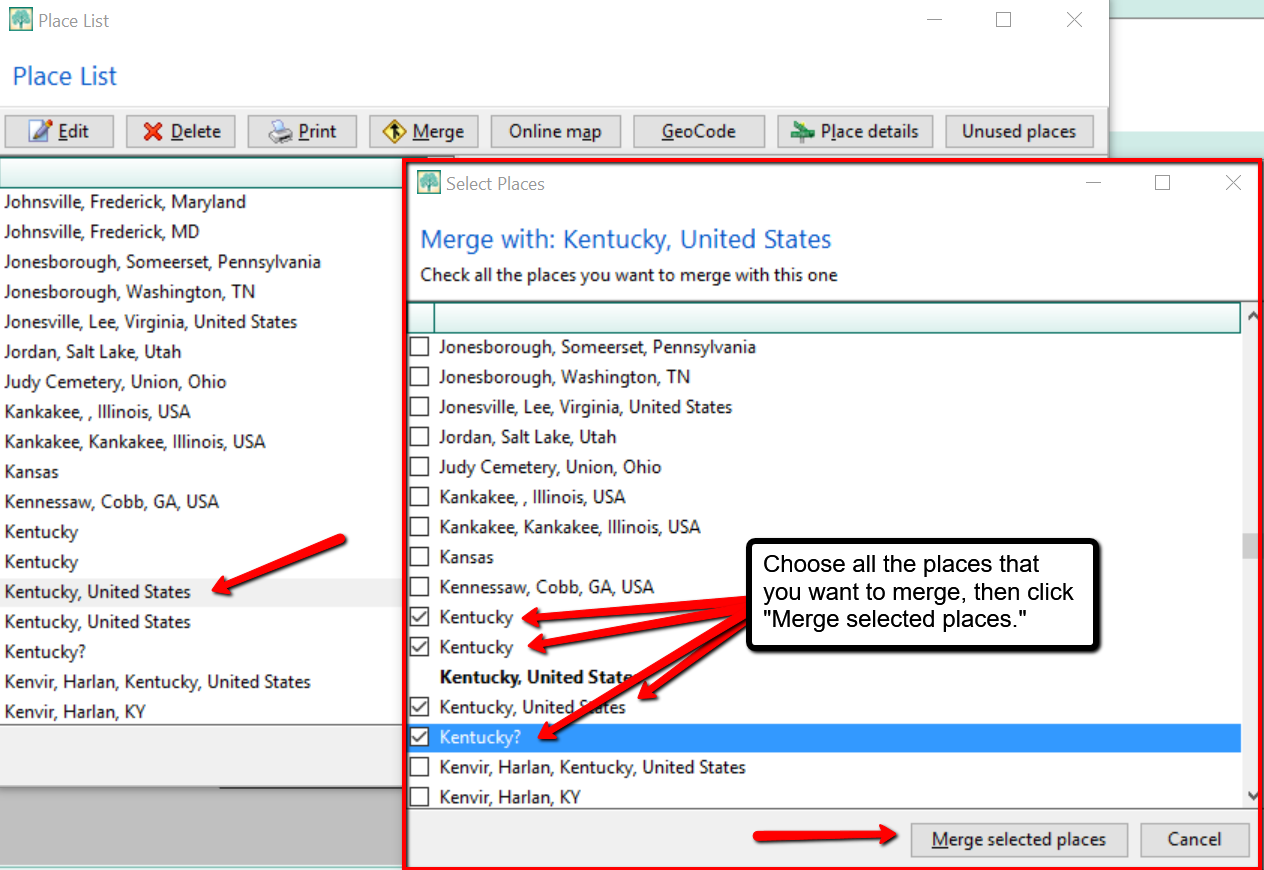
More on RootsMagic Software
RootsMagic is the genealogy software used and recommended by Lisa Louise Cooke and The Genealogy Gems Podcast. You can purchase this amazing software from the Products We Love tab in our store or by clicking on the RootsMagic 7 image link. When you use our affiliate links, you are helping to support the free Genealogy Gems Podcast. Thank you!
is the genealogy software used and recommended by Lisa Louise Cooke and The Genealogy Gems Podcast. You can purchase this amazing software from the Products We Love tab in our store or by clicking on the RootsMagic 7 image link. When you use our affiliate links, you are helping to support the free Genealogy Gems Podcast. Thank you!
by Lisa Cooke | Jan 28, 2017 | 01 What's New, FamilySearch, Records & databases
Sometimes you find yourself sorting through tons of people with the same last name to see which ones belong on your family tree. This surname research collection at FamilySearch can help you see what other researchers may have spent years compiling about thousands of family groups.
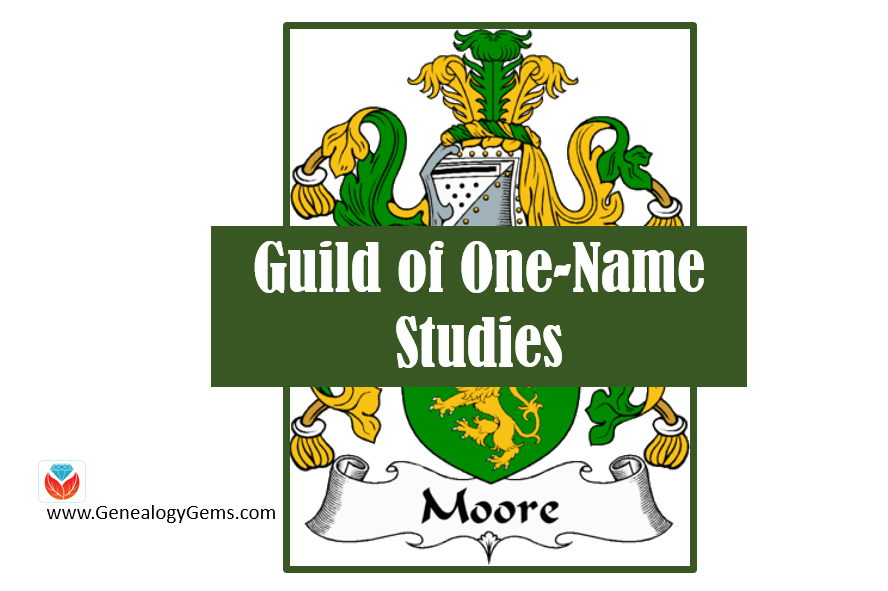
There’s a valuable free but much-overlooked online collection for surname research at FamilySearch.org. These are the family trees of nearly 3000 members of the Guild of One-Name Studies, who are studying nearly 9,000 different surnames. Their resources are strongest for the United Kingdom, where the Guild was founded, but you’ll find members all over the world.
What makes these family trees unique?
There are a couple of things that make these family trees unique:
1. These trees don’t just focus on a mostly-vertical line of ancestors for a single person. Members of the Guild collect everything they can about a particular surname and all its variants (hence the name of the organization). These efforts help organize and connect people with the same surname. Sometimes they help trace the origin of a surname. They can help people explore the variety of spellings and locations associated with different names.
2. These trees are often more fully researched and cited than your average online tree. The Guild takes pride in supporting its members in doing accurate, cited research; keeping their online databases updated; and responding to questions from others about their surname research.
Of course, always use caution when consulting others’ trees. Consider their content to be hints or suggestions until you prove them otherwise yourself. Scrutinize the sources they cite, many of which, say the Guild, aren’t available online elsewhere.
Explore the Guild Surname Research Collections
To explore this helpful free resource, follow the step-by-step instructions below:
1. Go to FamilySearch.org and click Search, then click Genealogies— not Records. (You may also click here to reach that landing page directly.)
2. Enter the surname of interest.
3. Click where it says All next to the Search button.
4. Select Guild of One-Name Studies.
5. Run the search. Click on search results to see:

A. The individual’s name, personal details and (scroll down) associated sources and citation details.
B. The individual’s place in a Guild family tree. Explore this family tree by clicking on someone’s name and seeing their information pop up to the left, where you can also click “View Tree” to see that person’s relatives.
C. Search for names within this tree.
D. This shows you what surname study the information comes from. In this case, you’re also given a link to a separate, associated website for that study.
6. Repeat to learn more about other surnames in your family.
More on Surname Research
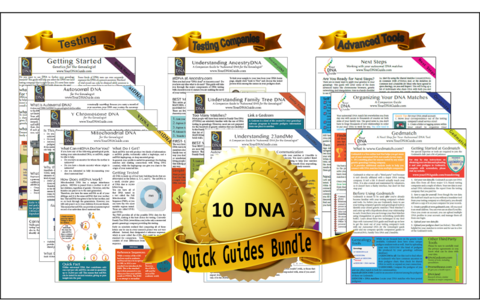 If you are interested in learning even more about surnames research, read Social Network Your yDNA with Surname Projects by our own Diahan Southard, and learn how surname study organizations are taking their research into the 21st century with DNA surname projects.
If you are interested in learning even more about surnames research, read Social Network Your yDNA with Surname Projects by our own Diahan Southard, and learn how surname study organizations are taking their research into the 21st century with DNA surname projects.
Also, learn more about utilizing DNA in your genealogy research with these 10 DNA quick guides from Your DNA Guide, Diahan Southard. They can be purchased in a bundle in either print or digital format.
by Lisa Cooke | Dec 22, 2023 | 01 What's New, Immigration, United States |
VIDEO & SHOW NOTES: Discover how to search for ancestors who may be included on the Ellis Island Immigrant Wall of Honor, and learn how you can honor ancestors’ by adding them to the list.
Watch Now:
Resources:
Download the ad-free Show Notes cheat sheet for this video here. (Premium Membership required.)
Show Notes: Ellis Island Wall of Honor
Millions of our ancestors came through Ellis Island in New York. Mine certainly did. So it’s a great place for genealogists to explore and learn new things about their family history. Well, there have been some changes and things happening over at the Ellis Island Foundation. And here to tell us more about it is Suzanne Mannion. She’s the Director of Public Affairs have the Statue of Liberty Ellis Island Foundation.

The American Immigrant Wall of Honor-Courtesy of Paul Seibert Photography
About the Ellis Island Wall of Honor
From Suzanne: The American immigrant Wall of Honor was introduced in 1990, when the Ellis Island Museum opened, originally, it was after the foundation had restored Liberty Ellis Island. It was a way to support the foundation. But more importantly, it was a way to celebrate people’s individual family immigrant experience.
Primarily it was Ellis Island immigrants and or their descendants whose names are on the on the wall for the start. Then over the years, it expanded. It’s now open to everyone, regardless of your immigration story or timeline.
It’s really been so well received. There are more than 800,000 names on the original wall of honor. So, that actually filled up and we had to turn people away and say, sorry, we’re filled up. Then through our partnership with the National Park Service, we were able to expand the Wall of Honor, which we just announced earlier this year.
The first round of names on the expanded wall are being submitted right now, and through the end of this year (2023). Those names will be unveiled in the summer of 2024. We were so excited that the Park Service gave us this opportunity, because people were disappointed thinking they had missed their chance to include their ancestors. So many people want to celebrate whether it’s themselves, their parents, or a loved one. They want to celebrate the immigrant experience, because that’s what Ellis Island is all about whether your family came here like mine in the in the mid-1800s or last year. It’s all about the celebration.
Names Expanded to All Immigrants
From Lisa: You might be really surprised to realize that many of the names that are on the wall are not people who came through Ellis Island. Normally at an historic site you would expect to see plaques and signage only referring to those involved with that site. So, I’m interested, when did that decision get made? When did it change from a wall of honor Ellis Island to including everybody?
From Suzanne: It was probably in the early 2000s. So, as you know, the Ellis Island database was launched in April of 2001.
Passenger Database Search
And so, with that people were celebrating the Ellis experience. Whether or not it’s true, I say oh, we should take some credit for helping genealogy become such a popular pastime! So, with that people came in, and even those visiting who didn’t have roots through Ellis Island, they felt the connection to America’s immigration story. So, people started asking if they could add their names to it. And it made complete sense.
Our goal is to continue expanding our database, so it has more ports of entry. And with that, we’re at the National Museum of Immigration.
So, we thought, let’s tell the whole story. So yeah, it’s been, I would say, well over a decade that the immigrant didn’t have to have come through Ellis Island to be included. I’m loving seeing and hearing other people’s stories and these different countries because it was very much a European thing like that. And now, they’re from all over the world.
Searching the Wall of Honor Database
From Lisa: You mentioned that there is a database. Before we try to submit a name, we’d like to check and see if the name is already there. Where can they search this database on the website, and would include any more information on that particular database besides just the fact that the names on the wall?
From Suzanne: Yeah, there’s two different databases. There’s the Ellis Island database through which one can trace family or anyone who came to the port of New York Between 1820 and 1957.
Ellis Island Passenger Database Search
And then the Wall of Honor database
Ellis Island Wall Of Honor and Database Search
In there you can see the name of the person who’s on the wall, and the person who submitted the name. So, some people do it for themselves. But it could be from Suzanne, “in honor of her great, great, Grandfather Michael Mannion.”
How to Add a Name to the Wall of Honor
From Lisa: What’s the process for adding our ancestor’s name? You mentioned that there might be a deadline. We’re recording here in 2023. Can they continue to add names into the new year?
From Suzanne: The opportunity is continuous. But what we do is we only put up a new panel once a year. So, from January 1 to December 31, people submit their names. Then at the beginning of the following calendar year, we create a new panel, and then we unveil it in early summer.
Add a Name to the Wall of Honor
So, if you want to make it onto that first panel of the wall expansion, then please submit the name or names by the by the 31st of December, 2023. But you can certainly participate after that.
Foundation Fundraiser and Cost
From Lisa: I believe this is a fundraiser for foundation correct?
From Suzanne: It is such a great way to show support for the foundation and the work that we do in restoring and preserving the two monuments. The cost starts at $275 for a one-line inscription.
Add a Name to the Wall of Honor
The website explains the process and the pricing. There are higher levels such as Steward levels, if you want more lines. That provides additional support for the foundation. Also, if you join, become a member at a certain level, that includes a wall of honor inscription. So, there are many ways to support the work that we do.
The History of the Foundation
We’ve been around since 1982. President Reagan asked Lee Iacocca to head up the effort to not only raise money, but to oversee the restoration of the statue and of Ellis Island for their Centennials. We’ve continued to work closely with our partners at the National Park Service.
In 2019 we opened the Statue of Liberty museum on Liberty Island.
Statue of Liberty Museum
It’s a small museum but with a big, big impact. There are beautiful visuals, and her original torch lives right there.
We don’t take government money to do any of the projects at the islands. It’s all through donations and has been since our inception. And we’re very proud of that.
From Lisa: I remember back in high school when Lee Iacocca was taking this on, and my grandmother was so excited because her parents had come through Ellis Island. It was in really tough shape back then. What stands there today is just amazing. It’s a wonderful experience. I encourage everybody watching to at some point make the visit because it really is heart touching.
EarthCam at Ellis Island
From Suzanne: Yes, and check out our website. We have some amazing views ! We are partnering with a company called EarthCam. You can see different views from the statue, and learn more
State of Liberty EarthCam
How Donated Money is Used
From Lisa: In the spirit of good stewardship, how is the money used? Does it only support the creation of the Ellis Island Wall of Honor? Or are there specific projects that you’ve had in mind this year that this money goes directly to that we can maybe look forward to in the future?
From Suzanne: Yeah, I can’t say right now. But I would love to come back in a few months to talk about a project we’re planning over on Ellis Island.
The donations that come via the Wall of Honor support the foundation’s mission in general, to restore and preserve the two monuments. And that includes maintaining the wall of honor.
Another thing that may inspire people to add the name this year is because costs are going up to not only create this new expansion and to maintain the wall, there will be a $25 increase in inscription starting January 1, 2024.
From Lisa: Suzanne, it’s always great to talk to you. Thank you so much for sharing this news. And I look forward to new and more news next year.
Resources:
Download the ad-free Show Notes cheat sheet for this video here. (Premium Membership required.)
by Lisa Cooke | Jun 26, 2015 | 01 What's New, Ancestry, Google, images, Military, Newspaper, Records & databases, United States

Every Friday, we blog about new genealogy records online. Do any of the collections below relate to your family history? This week seems to be all about U.S. records: newspapers, military and railroad employees.
U.S. NAVY SURVIVORS. A new collection with nearly 2 million records from case files of Navy approved pension applications (1861-1910) is now searchable on Fold3. These include Civil War survivors and later Navy veterans.
U.S. NEWSPAPERS. Over 450 historical newspaper titles for all 50 states (1730-1900) have been added to GenealogyBank. Over 160 of the papers date to the 1700s. Notable are an Ohio (Northwest Territory) paper from 1795, a New Orleans paper from 1803 and a Detroit paper from 1817.
PENNSYLVANIA NEWSPAPERS. Notable recent additions at Newspapers.com include nearly 400,000 pages of the Wilkes-Barre Record (1881-1949PA) and over 400,000 pages of the Standard-Speaker (1961-2000, Hazleton, PA).
U.S. RAILROAD RECORDS. Ancestry subscribers can access the Chicago and North Western Railroad Employment Records, 1935-1970. The line passed through Wisconsin, Minnesota, SD, Iowa and Nebraska. The collection includes Social Security numbers (born before 1912) and applications (with parents’ names), birth and death date, residences and occupational details.
 Google search tip: Though no longer actively digitizing and indexing newspapers, Google News Archive can help you locate online content for specific newspapers. Click here to access its alphabetical listing of newspapers. You can also enter keyword-searches in the search box on that webpage for all the newspapers listed here. There’s an entire chapter on the Google News Archive and what it can still do for us in The Genealogist’s Google Toolbox by Lisa Louise Cooke, fully revised and updated in 2015.
Google search tip: Though no longer actively digitizing and indexing newspapers, Google News Archive can help you locate online content for specific newspapers. Click here to access its alphabetical listing of newspapers. You can also enter keyword-searches in the search box on that webpage for all the newspapers listed here. There’s an entire chapter on the Google News Archive and what it can still do for us in The Genealogist’s Google Toolbox by Lisa Louise Cooke, fully revised and updated in 2015.







 is the genealogy software used and recommended by Lisa Louise Cooke and The Genealogy Gems Podcast. You can purchase this amazing software from the Products We Love tab in our store or by clicking on the RootsMagic 7 image link. When you use our affiliate links, you are helping to support the free Genealogy Gems Podcast. Thank you!
is the genealogy software used and recommended by Lisa Louise Cooke and The Genealogy Gems Podcast. You can purchase this amazing software from the Products We Love tab in our store or by clicking on the RootsMagic 7 image link. When you use our affiliate links, you are helping to support the free Genealogy Gems Podcast. Thank you!






